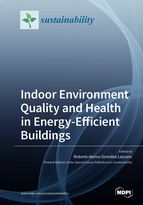Indoor Environment Quality and Health in Energy-Efficient Buildings
A special issue of Sustainability (ISSN 2071-1050). This special issue belongs to the section "Energy Sustainability".
Deadline for manuscript submissions: closed (28 February 2022) | Viewed by 27384
Special Issue Editor
Interests: efficient ventilation strategies; habits and comfort of the occupants; energy-efficient buildings; building codes and standards; indoor environmental quality; sustainable building materials; passive and active strategies; energy-saving strategies; lighting comfort; acoustic comfort; air quality monitoring; air pollution control; housing and health; HVAC control systems
Special Issues, Collections and Topics in MDPI journals
Special Issue Information
Dear Colleagues,
This Special Issue will address a topic of great relevance today, taking into account that in developed countries, most of the time is spent indoors and, depending on each person, presence at home ranges from 60% to 90% of the day, 30% of that time spent sleeping. Considering these data, indoor residential environments have a direct influence on human health, especially when accounting for the fact that in developing countries, significant levels of indoor pollution make housing unsafe, with an impact on the health of inhabitants. Housing is therefore a key health factor for people all over the world, and various parameters such as air quality, ventilation, hygrothermal comfort, lighting, physical environment, building efficiency, and others can contribute to healthy architecture, and the conditions that can result from the poor application of these parameters.
The articles will address issues concerning indoor environmental quality (IEQ), which are described more simply as the conditions inside the building. This includes air quality, but also access to daylight and views, pleasant acoustic conditions, and occupant control over lighting and thermal comfort. It also include the functional aspects of the space, such as whether the layout provides easy access to tools and people when needed and whether there is sufficient space for the occupants. Building managers and operators can increase building occupant satisfaction by considering all aspects of IEQ rather than focusing on temperature or air quality alone.
Within these objectives, housing ventilation becomes a challenging goal to solve as it is directly related to occupants’ health and wellbeing. The biggest challenge is its strong connection to energy demand as a big share of building energy losses are due to air renovations and enclosure infiltrations.
In this Special Issue, we look for a range of innovative research and evidence-based policy ideas that demonstrate the importance of housing research and policy for health and wellbeing.
Prof. Dr. Roberto Alonso González Lezcano
Guest Editor
Manuscript Submission Information
Manuscripts should be submitted online at www.mdpi.com by registering and logging in to this website. Once you are registered, click here to go to the submission form. Manuscripts can be submitted until the deadline. All submissions that pass pre-check are peer-reviewed. Accepted papers will be published continuously in the journal (as soon as accepted) and will be listed together on the special issue website. Research articles, review articles as well as short communications are invited. For planned papers, a title and short abstract (about 100 words) can be sent to the Editorial Office for announcement on this website.
Submitted manuscripts should not have been published previously, nor be under consideration for publication elsewhere (except conference proceedings papers). All manuscripts are thoroughly refereed through a single-blind peer-review process. A guide for authors and other relevant information for submission of manuscripts is available on the Instructions for Authors page. Sustainability is an international peer-reviewed open access semimonthly journal published by MDPI.
Please visit the Instructions for Authors page before submitting a manuscript. The Article Processing Charge (APC) for publication in this open access journal is 2400 CHF (Swiss Francs). Submitted papers should be well formatted and use good English. Authors may use MDPI's English editing service prior to publication or during author revisions.
Keywords
- thermal comfort
- air quality monitoring
- indoor air quality
- indoor environment quality
- building innovation systems
- health outcomes
- housing and health
- smart home for health
- smart home for elderly care
- indoor air quality
- efficient interior lighting systems
- acoustics
- infrasound
- environmental buildings
- passive building strategies
- TVOC
- air pollution
- energy efficiency
- sustainable materials
- green architecture
- sustainable architecture
- healthy architecture
- sustainable construction






